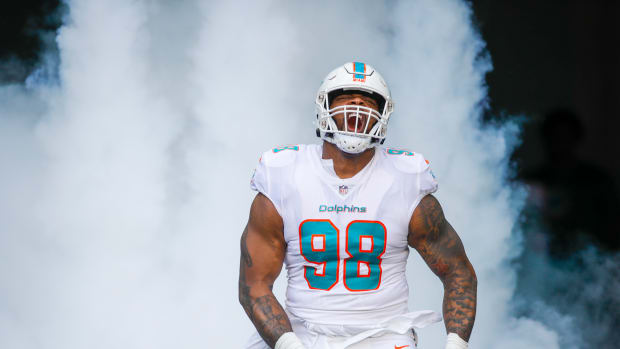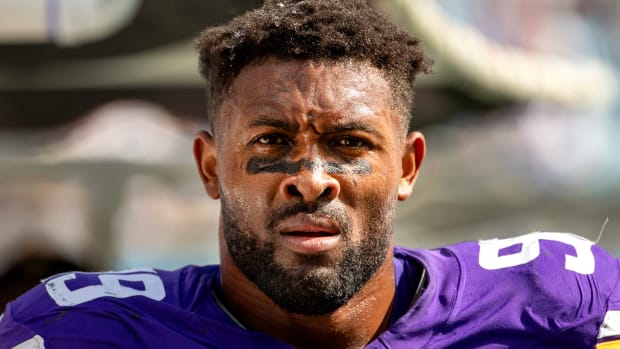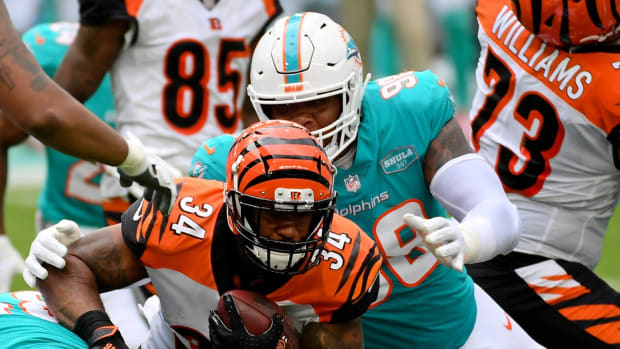Ranking Four Years Worth of Running Back Prospects
We’ve heard this is a historic running back class, with as many as four players (Dalvin Cook, Leonard Fournette, Alvin Kamara and Christian McCaffrey) being discussed as first-round possibilities and a fifth (Joe Mixon) who would be in the mix if not for off-field baggage. But how good is the 2017 crop really? Have RB stocks been inflated because of an otherwise so-so year for offensive prospects? Are they getting a boost because of the first-year success of Ezekiel Elliott in Dallas and (before a sophomore slump) Todd Gurley for the Rams, causing the first-round running back to come back into vogue?
So we at The College Column performed an experiment: I asked an evaluator from an NFL team to check his final grades on recent top running back prospects, dating back to 2014, and then factor in the 2017 class. (Confession: This is not my idea. Robert Klemko conducted this exercise two years ago with quarterbacks, when Marcus Mariota and Jameis Winston were the top QB prospects.)
Here, then, is Team X’s Top 15 running back prospects since 2014:
1. Ezekiel Elliott, Ohio State (2016)
2. Leonard Fournette, LSU (2017)
3. Dalvin Cook, Florida State (2017)
4. Todd Gurley, Georgia (2015)
5. Melvin Gordon, Wisconsin (2015)
6. Joe Mixon, Oklahoma (2017)
7. Derrick Henry, Alabama (2016)
8. Carlos Hyde, Ohio State (2014)
9. Alvin Kamara, Tennessee (2017)
10. Christian McCaffrey, Stanford (2017)
11. Tre Mason, Auburn (2014)
12. Jeremy Hill, LSU (2014)
13. Jordan Howard, Indiana (2016)
14. Tevin Coleman, Indiana (2015)
15. D’Onta Foreman, Texas (2017)
In the interest of debate, here is the evaluator’s view on the top of the list:
SCOUT X: First, I think it’s important for your readers to remember that running back can be a subjective evaluation. You might think it’s more straightforward than quarterback, where there are thousands of variables, but there’s a lot take in with running back also. You need to consider scheme fit, versatility, wear-and-tear, medicals, workload and, of course, everything off the field.
The MMQB: Do you think people will be surprised to see Elliott at No. 1?
SCOUT X: Maybe. He was so well-rounded coming out of Ohio State. He’s not the fastest guy you’ll see, but his first step, burst and vision are all elite. He was so much more advanced in blocking pass protection than Gurley or Fournette. He’s a workhorse and not only a three-down back, but he could be featured in the pass game as well. If you’re looking for a pure physical runner, with the best power/speed combination that most of us have ever seen, then Fournette is your guy.
The MMQB: Considering how high Joe Mixon is on this list, I’m assuming these are football-only grades?
SCOUT X: Correct. Look, everyone’s evaluations are different. So yeah, there are a few guys on this list who had some dirt off the field we had to sort out in evaluations and that can affect where they’re drafted. Or not. It just depends. There were concerns about Zeke at Ohio State, his personality and off-the-field curriculars and how that would fit into a locker room. Obviously those who have studied Mixon have gathered a ton of information and just like any prospect, we factor that into our evaluators. But Mixon is a unique case, because on the scouting side we can come up with our assessment for him, but [whether to draft him is] an ownership decision.
The MMQB: I’m surprised to see McCaffrey at No. 10, followed by Tre Mason. Is there a big gap between those two?
SCOUT X: You media love McCaffrey! I like him too. In this year’s class, I think his evaluations vary the most from team to team. I’d have some concerns about using him as an every-down back but I know he has value all over the field. As for Tre Mason? I know you remember him as a bust, and it’s clear he’s going through some troubles right now. He did lack ideal size, but watch some of that tape from 2013—his patience, his vision, his acceleration—you’d see why so many people were high on him.
* * *
THE SMARTEST QB IN THE DRAFT
Joshua Dobbs is a classic over-achiever. At Tennessee, he started as a true freshman. He led the Volunteers to three straight bowl wins. He majored in aerospace engineering. He spent the summer of 2015 interning for Pratt & Whitney, an aerospace manufacturer. Last season, he recorded 3,781 yards of total offense, second-most in school history behind only Peyton Manning.
Dobbs has maintained a relationship with the school’s most famous football alum. “I would text Peyton throughout his career, and he would respond on a constant basis,” Dobbs says. “I know it’s rare, and I learned how to take advantage of the connection. But you can’t give away too many of his secrets, or you might not have that relationship.”
For as precocious as Dobbs was in college, the NFL views the quarterback through a different lens: developmental prospect. In this column we have delved into the draft’s Top 5 quarterbacks (DeShone Kizer, Patrick Mahomes, Mitchell Trubisky, Deshaun Watson and Davis Webb), all of whom would be asked to run an NFL offense soon. Dobbs headlines a second tier: Quarterbacks that teams believe could have the capacity to run a team, but it would need to invest time to get there. Though he has a quick release and throws a decent deep ball, most of Dobbs’ college records came due to his ability to run (he joined Dak Prescott and Tim Tebow as the only SEC quarterbacks with 15 passing touchdowns and 10 rushing touchdowns in multiple seasons). The importance of his rushing ability will be diminished in an NFL offense. There are concerns about Dobbs’ accuracy and decision-making, including the 12 interceptions he threw last season.
But Dobbs, 6' 3" and 216 pounds, is keeping his stock afloat with an “It” factor. He dazzled in interviews at the combine. “I was very impressed by him in our session,” says an evaluator whose team interviewed Dobbs in Indianapolis. “His football IQ is exactly where you want a starting QB to be.”
“I guess I just don’t get it when people call me a developmental prospect,” Dobbs says. “It downplays my skills and my ability. Yes there’s a learning curve, no matter who you are, at the next level. But there are guys that have taken the reigns and just run with it. We saw it last year with Dak. We saw it with Russell Wilson. You need to give someone a chance to see what they can do. So I don’t really get the whole developmental term in general.”
When a few teams at the combine asked Dobbs if he’d be able to handle an NFL playbook, he was incredulous. “My senior year I was taking astronautics, propulsion and an aerodynamics class... all on the same day,” he says. “At the same time as football season when I was leading an SEC team. I think I can handle it.” As he plows through the pre-draft process—Senior Bowl, the combine and private workouts—Dobbs has been chipping away at his senior design project, where he needs to design, build then fly an airplane. He’s six credits shy of graduating. He simply has no time for Are you too smart to play football? inquiries. “I shouldn’t be punished for having a second passion, or plan for after playing football,” Dobbs says (in a refrain I’ve heard from John Urschel, the Baltimore Ravens guard, a published mathematician who studies at MIT in the offseason).
Dobbs, the only child to Stephanie (now retired, but a manager in corporate HR at UPS) and Robert (a VP at Wells Fargo), takes an analytical approach to football. He speaks of the game clinically—“What is the play caller’s intent? What is everyone’s role on a given play in order for the game to be successful?”—which is interesting as teams try to bridge the disconnect between his off-field intelligence and split-second decision-making.
That’s not to say Dobbs is a robotic player. His improbable 43-yard Hail Mary to defeat Georgia was a Top 10 college highlight last year. He cites a play against Florida as his favorite, a reminder of his physical toughness. “We called it ‘Danger,’” he says. “Third-and-8, we were up three. They were in man coverage and the play was drawn up for Josh Malone. It’s a quick slant, he crosses and runs for the touchdown… as I get blown up in the backfield. It’s beautiful football.”
I usually ask prospects to give me a scouting report of themselves. Of the nearly two dozen times I’ve done this, Dobbs was the only one to immerse himself fully in the role play, carefully choosing his language and keeping in third person the entire time. In his words:
“Joshua Dobbs is a quarterback from the University of Tennessee... Four year starter at the U of T. Understands what it’s like to be the face of a program. His on the field characteristics: He's tough, physically and mentally understands the game. Understands play caller’s intent and what the defense is doing. He can stand in the pocket and make throws but he can also break the pocket and make plays if things break down. Joshua Dobbs has a bright future and has the opportunity to be the face of a franchise and be a productive quarterback in the National Football League for any team that gives him the opportunity.”
•THE COLLEGE COLUMN ON THE QBS: Mitch Trubisky | Deshaun Watson | DeShone Kizer | Patrick Mahomes | Davis Webb | Nathan Peterman | Chad Kelly
* * *
FIVE THINGS YOU NEED TO KNOW
1. I was in Lubbock, Texas last week for Patrick Mahomes’ Pro Day (much more on that later this week at The MMQB) and I can report: His stock is as high as ever. Since the combine, Mahomes has scheduled 18 team visits or private workouts, meaning more than half of the NFL is doing its due diligence. Mahomes’ 68-throw session wasn’t perfect (he overthrew at least two routes and afterward said he wish he drove better on some of his throws to the left) but evaluators in attendance remarked that he has improved each time that they’ve seen him. The highlight was a 78-yard Hail Mary as the finisher, highlighting his unique arm strength.
2. This is the final week of pro days, and the schedule has thinned out tremendously. The biggest attraction left is LSU, on Wednesday, featuring its pair of potential Top 10 picks: safety Jamal Adams and running back Leonard Fournette. Carolina Panthers coach Ron Rivera says he’ll attend, telling reporters at the owners meetings that Fournette is a prospect he wants to learn more about, and that the No. 8 pick is not too high, in his opinion, to draft a running back. Meanwhile Adams is an elite, hard-hitting safety who is not expected to fall out of the Top 5; however he was unhappy with his 40 time at the combine (4.56) and, like Myles Garrett, is expected to run it again at his pro day to prove his competitive drive.
3. Chad Kelly is running out of time to impress NFL evaluators. The Ole Miss senior quarterback cut his pro day short on Monday after re-aggravating a wrist injury. Kelly, who has been rehabbing an ACL surgery through the draft process thus far, was only scheduled for a script of 35-40 throws (about 15 less than a typical pro day script). He only made it through five throws on Monday. Kelly will reschedule a workout for April 22, though that’s a short turnaround for NFL evaluators who already have concerns about Kelly off the field, as well as with the health of his knee.
4. Texas running back D'Onta Foreman definitely helped himself with a very strong pro day last week. His combine workout, including the 40, was cut short after doctors found a stress fracture in his foot. It wasn’t serious, as Foreman was able to run last week—and he ran well: 4.45 (though remember, that’s a hand time). Foreman is down 12 pounds from his listed college weight, now checking in at 237 (among his diet tips: less ranch dressing) which leads to this stat from NFL.com’s Gil Brandt: “Using combine data since 2003, no RB weighing 232+ has ever run that fast.”
5. As Philadelphia prepares to host the 2017 Draft, it’s not too early to wonder if the City of Brotherly Love will get an encore. When the NFL broke its longstanding partnership with Radio City Music Hall, it felt like it was shifting to a new model of the draft as a traveling road show. As of last spring, more than half of the league’s cities, plus Canton, Ohio, told the NFL they wanted to be considered. Last week, Chiefs president Mark Donovan told the Kansas City Star that Kansas City was “serious” about hosting the draft in the near future—even sending a contingent to Philly on April 27 to do recon. Packers president Mark Murphy submitted proposals to host each draft between 2019 and 2021, according to the Milwaukee Journal Sentinel. The draft is a nice alternative (and cash cow) for cites that might not be fit to host a Super Bowl. However I wouldn’t count out Philadelphia hosting again in 2018, just as Chicago had a two-year stint as host. The NFL will decide their intentions for 2018 in May.
* * *
MAILBAG!
I’ll be fielding questions every week between now and the draft. If you’d like to send a question to The College Column for next week’s mailbag, tweet @emilymkaplan or email talkback@themmqb.com.

Penn State’s Barkley is an early Heisman front-runner, and is already the subject of 2018 draft buzz.
Leon Bennett/Getty Images
@dtlebaron: Top three RBs not named Saquon Barkley who could win the Heisman next season?
I respect you for proactively blocking my Nittany Lion bias here. (O.K., can’t help it. Two things on Barkley: As impressive as he was last season, a Northeast scout told me the “I know you like him, and the hype is 100 percent warranted” for 2017. And he clocked a 4.33 in the 40 for spring testing.) But you want to know about other running backs. LSU’s Derrius Guice is the name you need to know. Over the past two years, Guice has flashed his potential when relieving Leonard Fournette. He already has recorded two 250-yard games—in the span of 13 days!—and with a career rushing average of 7.8 yards per carry so far he could threaten Bo Jackson’s SEC record (6.62, with a minimum of 400 rushes). Plus, he’s playing in LSU’s offense, which is always run-heavy and questionable at quarterback. Georgia’s Nick Chubb is another back to watch. I was surprised to see he returned to school for his senior year; should he stay healthy (and doesn’t have to split too many reps with Sony Michel) he’s poised for production. And of course, there’s an Alabama running back on the scene: Bo Scarbrough.
@ChrisN_H: Which player represents the biggest project for an NFL team in the coming draft?
You could argue Patrick Mahomes, in the sense that the quarterback is likely to be drafted high, though most evaluators agree he would be best off sitting on the bench for at least a year so coaches can sort out his mechanics and footwork. Another name I would throw out is Julién Davenport, the offensive lineman from Bucknell. Evaluators are obsessed with his length—6'6" (and 3/4), with 36-inch arms and an 87-inch wingspan—and athleticism, but he needs work and by virtue of playing in the Patriot League, doesn’t have much experience against top-end competition. As an evaluator told me earlier this year: “He’s a developmental pick with true left tackle upside. Lacks core strength, but love the body, length and wingspan.” In a thin year for offensive linemen, I can see Davenport going as high as the third round.
@Neilschoolnik: Which QB will be a surprise pick?
Would you be surprised if Davis Webb were drafted at the end of the first round? I would. I think there’s a very outside chance of that happening, but I wouldn’t count the former Texas Tech and Cal quarterback out for second round. NFL teams know Webb is probably not ready to start in 2017, but many have become smitten by Webb in interviews and classroom sessions, believing he could be their quarterback of the future. And then there’s Joshua Dobbs (highlighted earlier in this column). I don’t think he’ll be a surprise in the position he’s drafted (I peg him at Day 3) but I think he has the capacity to outperform expectations. As for a classic “I can’t believe that guy was drafted” surprise, remember this name: Alek Torgersen from the University of Pennsylvania. He’s the type of prospect (good size, decent accuracy and intelligent) a team would love to take a seventh-round flyer on and see if he can develop on the practice squad.
@TPT1961: How many teams in addition to Pats have taken Joe Mixon off their draft boards. Side comment....Mixon is gonna be really good in NFL.
Hi Todd. I delved into Mixon’s stock in the mailbag last week, but there’s at least one other team that I know of that has removed the running back from their board. There could be more; that’s just all I know of. If reports that the Patriots took Mixon off their board are true, that’s at least two teams.
Question or comment? Email us at talkback@themmqb.com.





































